| Columns Retired Columns & Blogs |
Meridian 208 CD player/preamplifier Measurements
Sidebar 3: Measurements
Looking first at the 208's preamplifier section, the output impedance from the variable outputs was a low 12.5 ohms, meaning that the 208 should not be fazed by long or very capacitive cables, or low power-amplifier input impedances. The maximum output level (for 1% THD) was a hefty 10.02V RMS, this obtained with a 1.02V RMS input and the volume control at maximum (64). (With a CD, this maximum output was obtained from a 0dB signal with the control set to 57.) The volume control itself showed excellent channel matching, the difference between channels averaging less than 0.05dB from level 64 down to level 16, below which the difference reached a maximum of 0.3dB at the lowest setting (1). The steps themselves varied between 0.7dB and 1.3dB in a regular pattern.
The line stage is non-inverting, but its frequency response showed a somewhat anomalous behavior. With the volume control at "64" and a 100mV input level, the response drooped by 1.2dB at 20kHz, as can be seen from the bottom curve in fig.1. Yet at lower settings of the volume control the response peaked up in the top octave by a fraction of a dB, again as shown in fig.1, implying that the HF rolloff of the 208's line stage is inversely proportional to the volume control setting, something I have not seen before. Apart from the premature rolloff when the volume control is near maximum, I doubt that this will be audible, however.
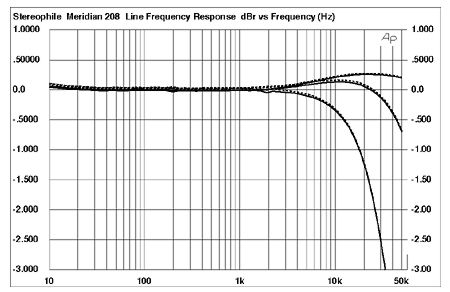
Fig.1 Meridian 208, line-input frequency response, 100mV inout, (right channel dashed), volume control at 32 (top), 48 (middle), and 64 (bottom). (0.5dB/vertical div.)
Distortion levels for the 208's line stage were astonishingly low. Fig.2 shows the THD and noise measured with a 1V input and the volume control at 48 averaging 0.03% across the band. Intermodulation levels also measured less than 0.01%. Channel separation was also excellent, as can be seen from fig.3, being greater than 95dB across the band with the undriven input shorted.
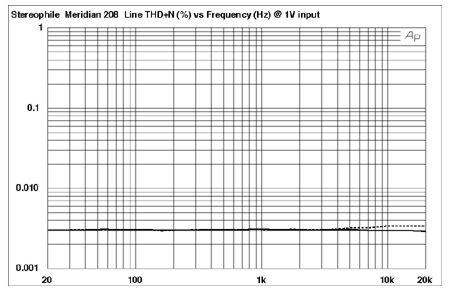
Fig.2 Meridian 208, line-input THD+noise (%) vs frequency, 1V input, volume control at 48 (right channel dashed).
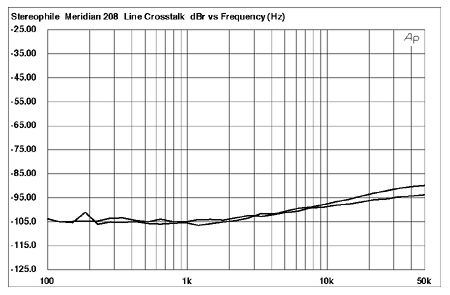
Fig.3 Meridian 208, line-input channel separation (5dB/vertical div.)
Turning to the CD player section with all measurement taken from the fixed outputs, fig.4 shows the frequency response, with a slight amount of passband ripple visible from the digital filter. The de-emphasis error (fig.5) shows the somewhat anomalous behavior that Robert Harley also found in the Meridian 203's performance last month. Channel separation was better than the 206; at worst, it was 78dB at 16kHz. The output impedance from the fixed outputs was a low 12.6 ohms, while the maximum output level was 0.86dB higher than the 2V standard at 2.208V. (Actually, I can't remember when I measured a CD player that had a true 2V maximum output level: presumably every manufacturer wants his player to sound that little bit louder than the competition in the dealer's sound room, hence the overall creep upward.)
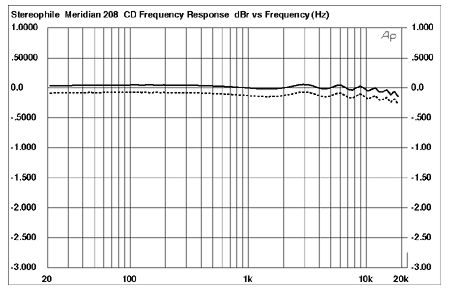
Fig.4 Meridian 208, CD frequency response (right channel dashed, 0.5dB/vertical div.)
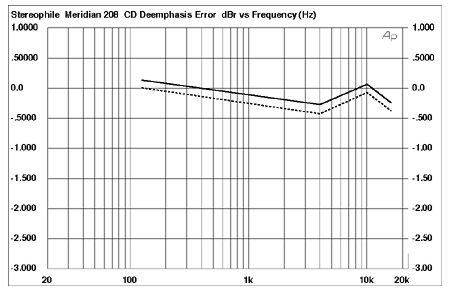
Fig.5 Meridian 208, de-emphasis error (right channel dashed, 0.5dB/vertical div.)
A 1kHz squarewave at maximum level reproduced with the Gibb's phenomenon "ringing" due to the linear-phase bandwidth limiting (fig.6), this unclipped. As with the Meridian 206, the 208's output is polarity-inverting. Flipping the polarity is a piece of cake with the remote control, however; owners should remember that the 208's CD output signal is non-inverted when the red polarity LED is lit. (This inversion is achieved by inverting the digital datastream from CD; the switch therefore has no effect on the 208's analog inputs.)
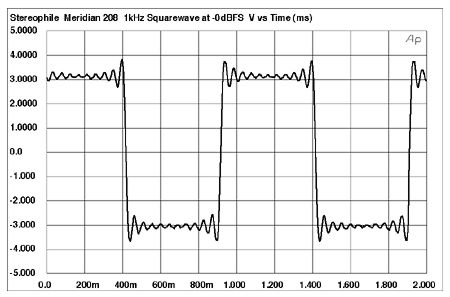
Fig.6 Meridian 208, 1kHz squarewave at 0dBFS.
Robert Harley enthused about the 203's linearity last month; the 208 was equally superb, as can be seen from fig.7, computed by the Audio Precision system from the data gathered while the player reproduced the 500Hz fade-to-noise with dither track on the CBS Test CD. Almost equaling the performance of the $12,000 Stax, the 208's actual output level is within a fraction of a dB of what it should be down to below -100dB and within +2dB to -114dB! (The curve shown is for the left channel; the right channel was identical.) The excellent linearity was confirmed by sweeping a bandpass filter across the audio band while the player plays the dithered 1kHz tone at -90.31dB from the CBS Test CD. (The dithering means that any distortion apparent on this tone is due to the player's electronics and not to the coarse signal quantizing at this level.) Note the absence of power-supply noise and of HF distortion harmonics in the resultant spectrum (fig.8).
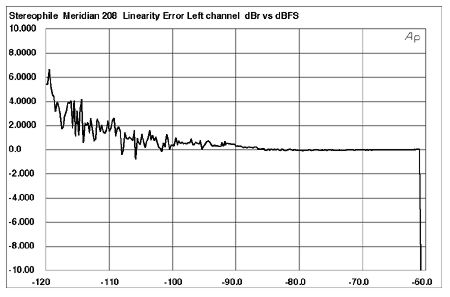
Fig.7 Meridian 208, left-channel departure from linearity (2dB vertical div.)
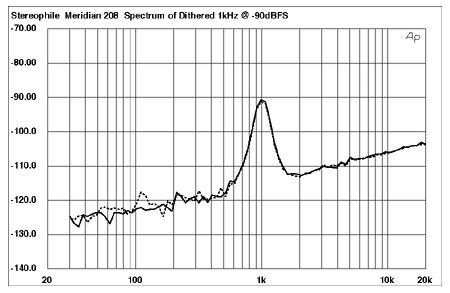
Fig.8 Meridian 208, 1/3-octave spectral analysis, dithered 1kHz tone at -90dB, with noise and spuriae (right channel dashed).
Listening to both the 128x-oversampled bonger track on the Chesky Test CD (JD37) and the CBS fade-to-noise track revealed a total absence of harmonics and heterodyne-type (shortwave radio) whistles superimposed on the pure tone as it descended into silence some 120dB down from peak level. Looking at the waveform of an undithered 1kHz tone (fig.9), the stepped waveshape can just be made out, overlaid with audio-band noise, reinforcing the 208's excellent low-level resolution. (See fig.10 in the Stax review, August 1990, p.110, for the best low-level resolution we have measured.)
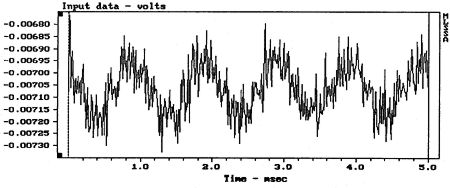
Fig.9 Meridian 208, waveform of undithered 1kHz sinewave at -90.31dBFS.
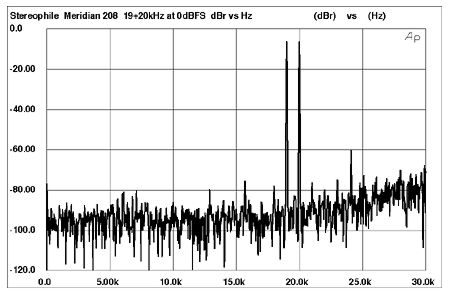
Fig.10 Meridian 208, HF intermodulation spectrum (linear frequency scale).
Error correction was among the best I have experienced—Meridian does claim much-improved error handling. The only tracks on the Pierre Verany Test CD to give the 208 any trouble were those featuring one or more 2.4mm gaps in the spiral data path—extreme groove damage!
Finally, I examined the 208's intermodulation performance with a signal consisting of a 1:1 mix of 19 and 20kHz tones, the composite waveform reaching a peak level of 0dB. The spectral analysis of the Meridian's output is shown in fig.10; there are no intermodulation products visible, apart from residual spikes at 18kHz and 20kHz, some 70dB down from the 19kHz level. The aliasing product at 24.1kHz (44.1kHz-20kHz) can be seen at -55dB, shown by the cursor position; though better suppressed than with machines using the Philips 4x-oversampling, 16-bit linear chip set, it is still a little higher in level than with the very best-sounding players.—John Atkinson
- Log in or register to post comments



































